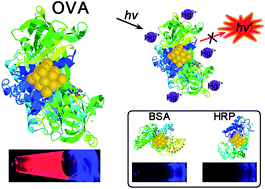Synthesis of ovalbumin-stabilized highly fluorescent gold nanoclusters and their application as an Hg2+ sensor
Abstract
Biomolecule-functionalized fluorescent gold nanoclusters (AuNCs) have attracted a lot of attention because of their good biocompatibility and considerable environmental/cost advantages. Recently, some proteins rich in tyrosine and cysteine have been proven to work as templates for the direct synthesis of AuNCs under alkaline conditions. However, the low quantum yield (QY) of AuNCs is still a restraining factor, which constrains its wide applications. In this study, highly fluorescent AuNCs have been synthesized in a basic aqueous solution using ovalbumin (OVA) as both a reducing and stabilizing agent. The QY of the ovalbumin-stabilized AuNCs (OVA@AuNCs) was found to be twice that of the reported BSA-stabilized AuNCs (BSA@AuNCs) under the same conditions. Moreover, the good pH stability and time stability of the OVA@AuNCs were examined. These properties will be helpful for AuNCs-based sensing and imaging. Further research revealed that the fluorescence of the OVA@AuNCs could be quenched by Hg2+ and it can be used as a sensor for sensitive Hg2+ detection with a detection limit of 10 nM.


 Please wait while we load your content...
Please wait while we load your content...